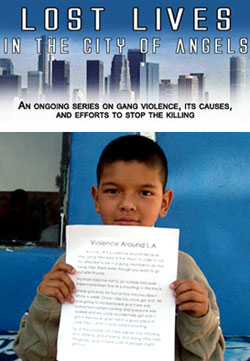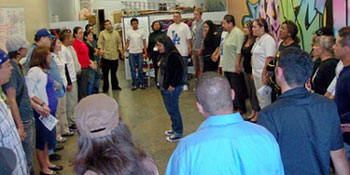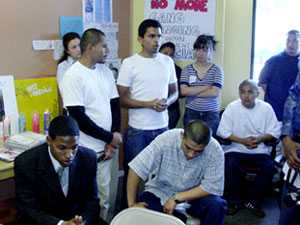- Fear of a Black-Brown race war in Los Angeles (FCN, 04-03-2008)
- Gang shootings stun Los Angeles (FCN, 03-20-2008)
- Building unity between Black and Brown (FCN, 07-05-2005)
- A Special Message to Black and Latino Street Organizations (FCN/Min. Farrakhan, 12-11-2004)

LOS ANGELES (FinalCall.com) – “No more research! No more hearings! No more gang-banging between government officials!” chanted some 100 Indigenous and Latino youth jam packed into Chuco’s Justice Center on March 26 as part of their call for local, state and federal authorities to bury these “dead-end” strategies to end gang violence and adopt three proven and simple solutions.
The Youth Justice Coalition spearheaded the action, which included several Black gang intervention workers and community leaders, all calling for city-wide funding for a three-point plan of action that would put 500 gang interventionists on the street by July; flood poor and working neighborhoods with jobs; and provide education, recreation, arts, job training and violence prevention in youth centers from 3 p.m. to 11 p.m., seven days per week.
The coalition began its meeting with a moment of silence for 37 youth murdered or seriously wounded in March alone. The victims ranged from ages six through 28. After the silence, they detailed plans for a safer community. The center, a school and community space, was named for Jesse “Chuco” Becerra, a youth organizer murdered outside a party in South Central L.A.
The youth also called for an immediate end to gang murders; increased support for children in the juvenile justice system or who have parents in the prison system; and reduced youth recidivism through education and employment.
L.A. officials keep ignoring the fact that study after study indicates youth development and gang intervention, not increased police suppression, will solve the gang problem, said the young leaders.
How many more studies will official’s conduct while youth between the ages of 14 and 25 continue to be slain? they asked, vowing to continue work to solve the problem themselves.

Though no city support means little or no funding or resources, the youth said they cannot wait for L.A. officials to catch up to their plans for survival and self-preservation.
They have cobbled together grassroots support from hardcore gang interventionists, mothers who lost children to violence, some non-profit agencies, educators and a collaborative of youth groups working on similar issues throughout Los Angeles County.
Some of the coalition’s participants include the Youth Justice Coalition (YJC), LaCasa Youth Build, the October 22nd Coalition, Project Cry No More, Save Our Future, Homies Unidos, Pathways to the Future and Stop Prisoner Rape.
During the meeting, moderators sought opinions about factors that impact youth and gang life, including fratricidal murders and violence between races; the impact of police, prisons and police brutality; what drives people to gang life; and how violence escalates to killing.
Part of their discussion focused on Black and Latino heritage, unity and similarities, and much of it targeted solutions designed for individual neighborhoods and building partnerships.
Gerald Thompson, founder of a gang intervention and prevention effort called Pathways to the Future, said one way to combat division is to break down ignorance and misperceptions about each other’s ethnicity. “There are different cultures and just because I look Black, I could be from Cuba. We should start studying each other’s history and know whom we’re talking to first so that we can unite,” he said.
Many youth admitted racial tension between Black and Brown communities does exist, but like 16-year-old Danielle Argueta, a YJC spokesperson, they believe the tension can be eased with appropriate tactics. Anyone serious about saving lives will make sincere efforts to close the gap that is widening between the two peoples, she said.
The racial divide is being agitated to provide an excuse for law enforcement to raid both communities, imprison youth and throw away the key, many believe.
“A lot of us come from single parent homes and grew up in the streets or projects because there’s no housing or redevelopment in our communities. Our problems are not just racial, and if you wonder why we’re dying, just look at how we’re living. This is what they want because this gives them a financial profit,” Ms. Argueta charged.
Gangs did not generate out of a vacuum, said the youth. Some charged the mainstream media with being irresponsible for reporting L.A.’s 60-year problem with gangs, without putting into context the real history of the movement and struggle of Blacks and Latinos in this country and region.

A speaker recounted a time, before the 1980s, when Black-Latino relations were less strained, but others noted that was before the U.S. government allegedly funneled drugs and guns into their communities, not to mention corporate exploitation of Latino workers for cheap labor, which Blacks fear is drying up employment.
Although the event was intended as an afternoon press conference, The Final Call was the only media present due to an earlier press conference at which LAPD Chief William Bratton, Mayor Antonio Villaraigosa, City Attorney Rocky Delgadillo and government officials celebrated recent gang arrests and discussed federal funding to combat gangs.
They held a meeting and press conference approximately one mile away from the youth gathering at the LAPD’s 77th Street Division.
Youth organizers noted the absence of city officials and the mainstream media, but were not discouraged or deterred.
“The fact that there is a meeting at the same time is an honor and shows that the YJC has been able to pull this many people forward for one day to deal with solutions and they have to take note of and try to counter that,” said a young, female college student.












